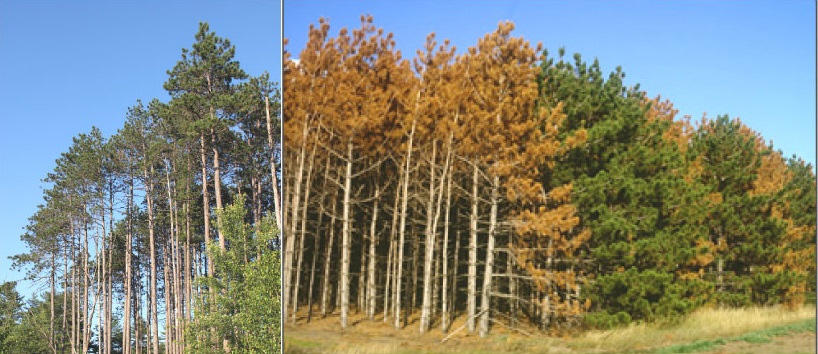SCORES & OUTDOORS: New England’s pines, white and red, are under siege

Left photo, a stand of healthy red pines. Above, red pines that have experienced needle color change. (Internet photos)
 by Roland D. Hallee
by Roland D. Hallee
A couple of weeks ago, while my wife and I made our semi-annual trip to my brother’s in Vermont, he pointed out to us all the pine trees that were a yellow-orange in color. We were on our way to Sunday morning breakfast when he asked me what I thought might be causing it. At first I attributed it to road salt – the state of Vermont is experimenting with a salt brine, which is supposed to be less invasive than the usual mix of rock salt and sand.
But something that was peculiar about that is that it was not only trees by the road, but also stands of red pines deeper into the woods. That was curious.
On our way home, my wife and I noticed that these yellowish-colored red pines did not exist in New Hampshire and western Maine. We figured it was a Vermont issue.
I only bring this up because on my way home from work later that week, I noticed the same thing happening to a stand of tall red pines along Lakeview Drive, in China. OK, now we need to investigate.
Here, in Maine, we have experienced a white pine needle damage epidemic for at least the last six years. The needles brown prematurely and drop very quickly, at least since 2014. I have witnessed that in my own backyard, a constant battle to keep up with all the fallen needles, year-round. That is caused by a brown spot needle blight.
But what is causing the yellowing of the red pines?
Craig Dusablon, landscape coordinator for the Vermont Agency of Transportation, said that road salt is the culprit, washing into the soil all winter long. A chloride concentration of just one percent can cause extensive plant injury, specifically in red and white pines. And it is not concentrated to trees by the roadside, it can also occur deeper in the upslope and downslope.
Red pines, however, are a different species. They have straight trunks, often used for utility poles, with hardly any branches down low, but with a tightly packed crown. They often compete with maples, beeches and white pines for space, but fair much better on rocky ridges where other tree species can’t get a toehold.
The signs of poor health are evident for years before the average red pine dies. The first signs of trouble appear on individual branches near the lower part of the crown, after which it spreads, with the needles slowly changing colors from a healthy green to a sickly yellow to a completely dry red that consumes the entire crown.
Researchers are not prepared to pin the tree deaths on any one killer. First up, in turn that seems more relevant in light of President Donald Trump’s withdrawal from the Paris climate agreement recently, is climate change. The fact is, while there’s near consensus in the scientific community, that the planet is heating up, it’s much harder to pin down the exact impact on any particular species. There could be climate factors that can contribute to tree stress, considering the periods of drought we have experienced over the last several years.
Another possibility is disease.
University of New Hampshire researcher Mike Simmons, who has been on the case, feels there may be some needle pathogens causing mortality or tree decline as well. “At this point, we don’t have conclusive evidence if there’s a uniform factor across all these stands.”
Though he won’t clear these suspected tree killers, or rule out the possibility that they may be working in concert to undermine the health of red pines, Simmons is really focused on a prime suspect: red pine scale, a tiny, near microscopic insect that crawls beneath the tiniest of bark flakes, injects its mouth into the tree’s vascular tissue, serving as a path for the distribution of food material, and begins to feed, sucking sugars and other metabolic products as the trees try to circulate them from the sun-catching needles to the rest of the tree’s body. The invasive insect was first discovered in Vermont in 2015.
No one knows for sure what’s allowed the bug to spread into local forests, with climate change and human migration both possible causes. Since its arrival in the Northeast, it’s been wreaking havoc. It has the potential to wipe out a whole species from certain areas.
Though there is no known cure for red pine scale, officials hope to slow or contain it by removing infested trees, and encouraging the public not to transport wood that may contain the pest.
Roland’s trivia question of the week:
With Red Sox outfielders Mookie Betts being named the American League Most Valuable Player for 2018, who was the last Red Sox outfielder to be named MVP?
Responsible journalism is hard work!
It is also expensive!
If you enjoy reading The Town Line and the good news we bring you each week, would you consider a donation to help us continue the work we’re doing?
The Town Line is a 501(c)(3) nonprofit private foundation, and all donations are tax deductible under the Internal Revenue Service code.
To help, please visit our online donation page or mail a check payable to The Town Line, PO Box 89, South China, ME 04358. Your contribution is appreciated!


Leave a Reply
Want to join the discussion?Feel free to contribute!